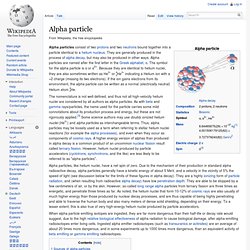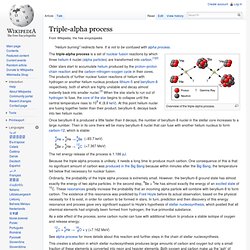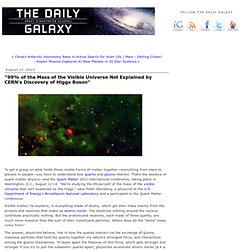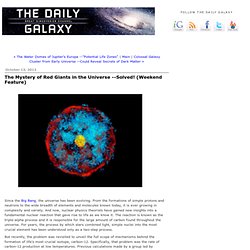

Alpha particle. Alpha particles consist of two protons and two neutrons bound together into a particle identical to a helium nucleus.

They are generally produced in the process of alpha decay, but may also be produced in other ways. Alpha particles are named after the first letter in the Greek alphabet, α. The symbol for the alpha particle is α or α2+. Because they are identical to helium nuclei, they are also sometimes written as He2+ or 4 2He2+ indicating a Helium ion with a +2 charge (missing its two electrons). If the ion gains electrons from its environment, the alpha particle can be written as a normal (electrically neutral) Helium atom 4 2He.
The nomenclature is not well defined, and thus not all high-velocity helium nuclei are considered by all authors as alpha particles. Alpha particles, like helium nuclei, have a net spin of zero. Triple-alpha process. Overview of the triple-alpha process.

The triple-alpha process is a set of nuclear fusion reactions by which three helium-4 nuclei (alpha particles) are transformed into carbon.[1][2] Older stars start to accumulate helium produced by the proton–proton chain reaction and the carbon–nitrogen–oxygen cycle in their cores. The products of further nuclear fusion reactions of helium with hydrogen or another helium nucleus produce lithium-5 and beryllium-8 respectively, both of which are highly unstable and decay almost instantly back into smaller nuclei.[3] When the star starts to run out of hydrogen to fuse, the core of the star begins to collapse until the central temperature rises to 108 K (8.6 keV).
At this point helium nuclei are fusing together faster than their product, beryllium-8, decays back into two helium nuclei. Once beryllium-8 is produced a little faster than it decays, the number of beryllium-8 nuclei in the stellar core increases to a large number. Discovery[edit] "99% of the Mass of the Visible Universe Not Explained by CERN's Discovery of Higgs Boson"
Visible matter, he explains, is everything made of atoms, which get their mass mainly from the protons and neutrons that make up atomic nuclei.

The electrons orbiting around the nucleus contribute practically nothing. But the protons and neutrons, each made of three quarks, are much more massive than the sum of their constituent particles. Where does all the "extra" mass come from? These collisions recreate conditions that last existed early in the universe, before quarks joined up to form protons and neutrons. Studying the behavior of "free" quarks and gluons in this primordial quark-gluon plasma should help scientists better understand the strong force, and how it generates so much of the mass we see when the particles coalesce to form ordinary matter. So, while visible matter accounts for a mere fraction of the total universe—just five percent, the rest being composed of dark matter and mysterious dark energy—it's enough to provide physicists like Steinberg with a lifetime of work.
First glimpse of the dynamics of a red giant. Click here to view more high resolution (2512x3300 pixel) Red Giant images. Click here to view more Red Giant movies, as well as other LCSE movies. The Mystery of Red Giants in the Universe. Since the Big Bang, the universe has been evolving.

From the formations of simple protons and neutrons to the wide breadth of elements and molecules known today, it is ever growing in complexity and variety. And now, nuclear physics theorists have gained new insights into a fundamental nuclear reaction that gave rise to life as we know it. The reaction is known as the triple-alpha process and it is responsible for the large amount of carbon found throughout the universe. For years, the process by which stars combined light, simple nuclei into the most crucial element has been understood only as a two-step process. But recently, the problem was revisited to unveil the full scope of mechanisms behind the formation of life's most crucial isotope, carbon-12. Carbon is the fourth most abundant element in the universe, and carbon-12 is its most common form.